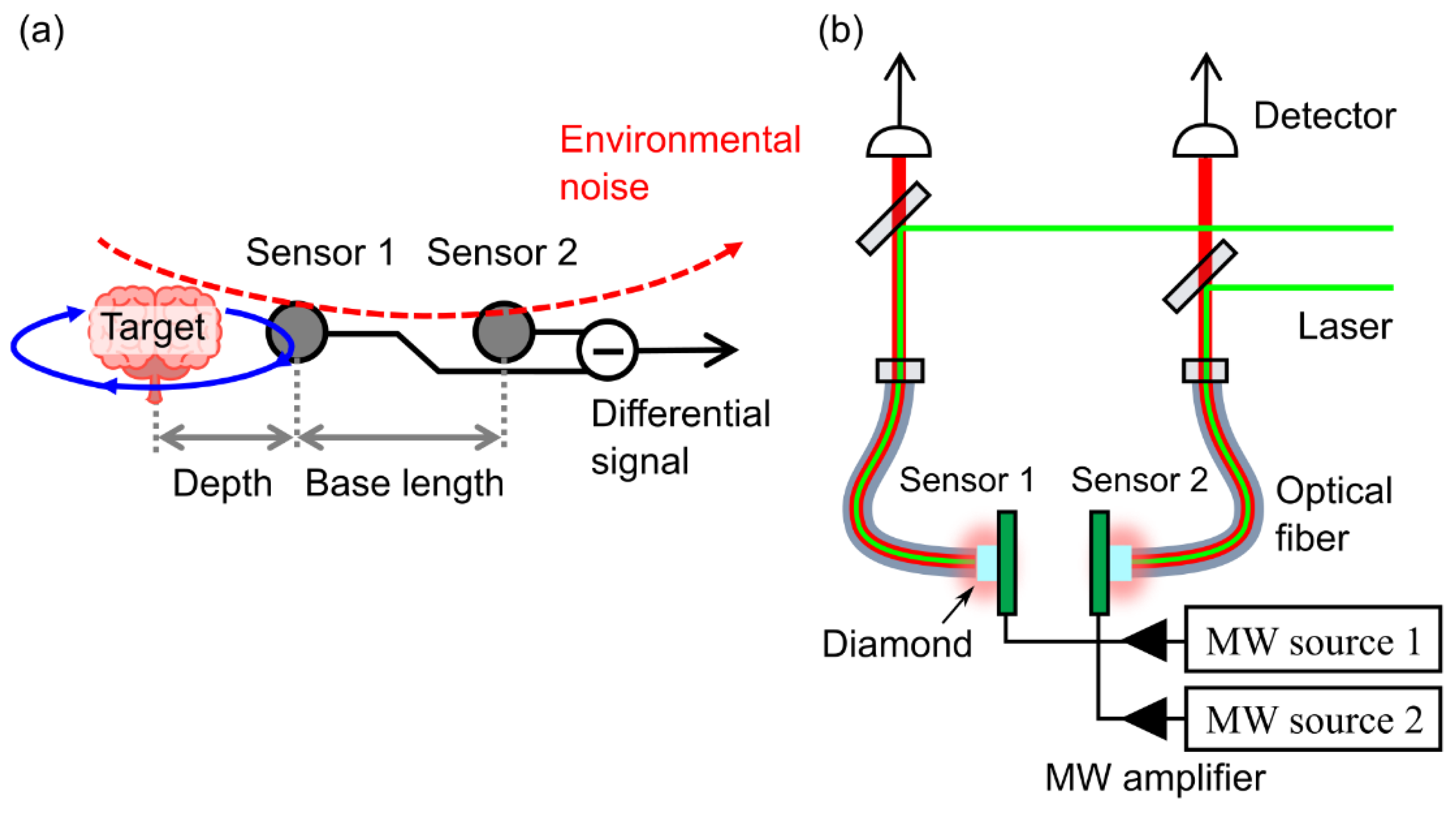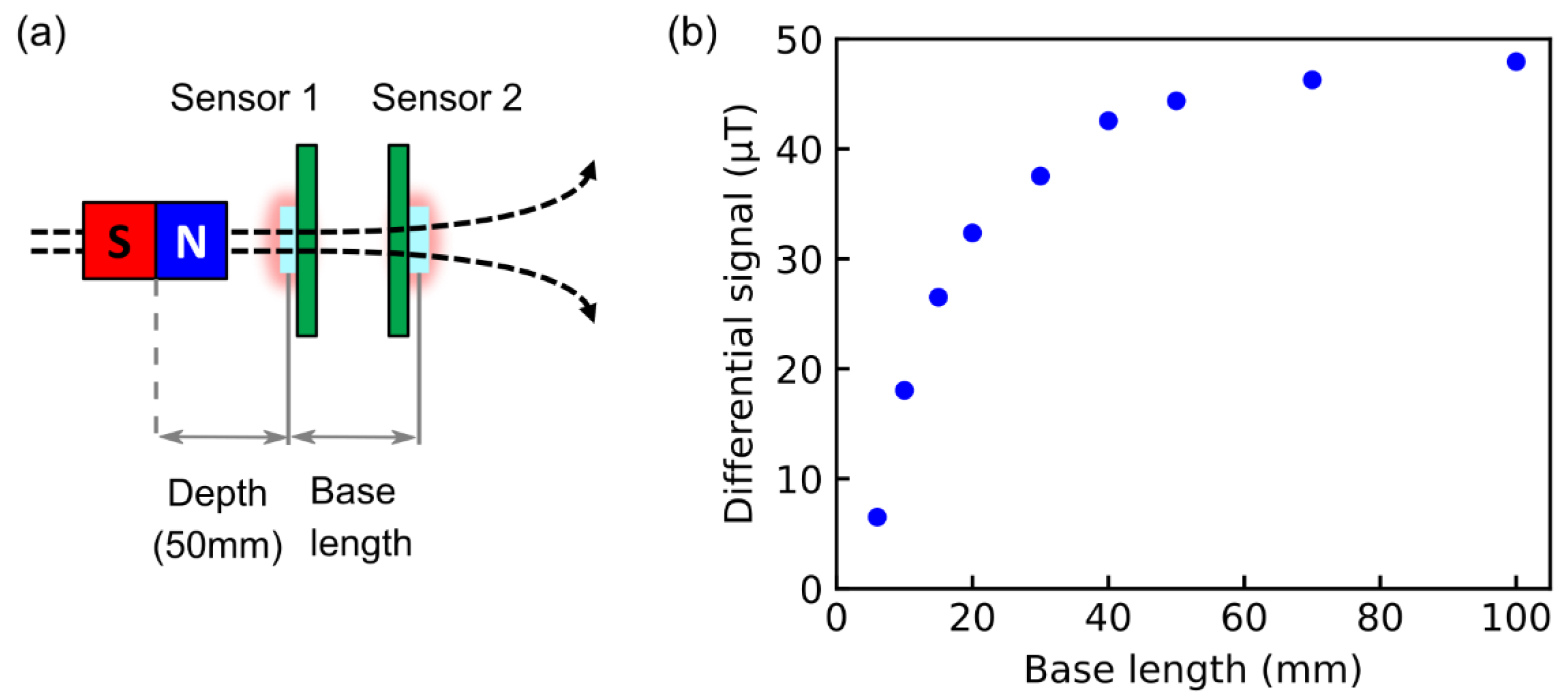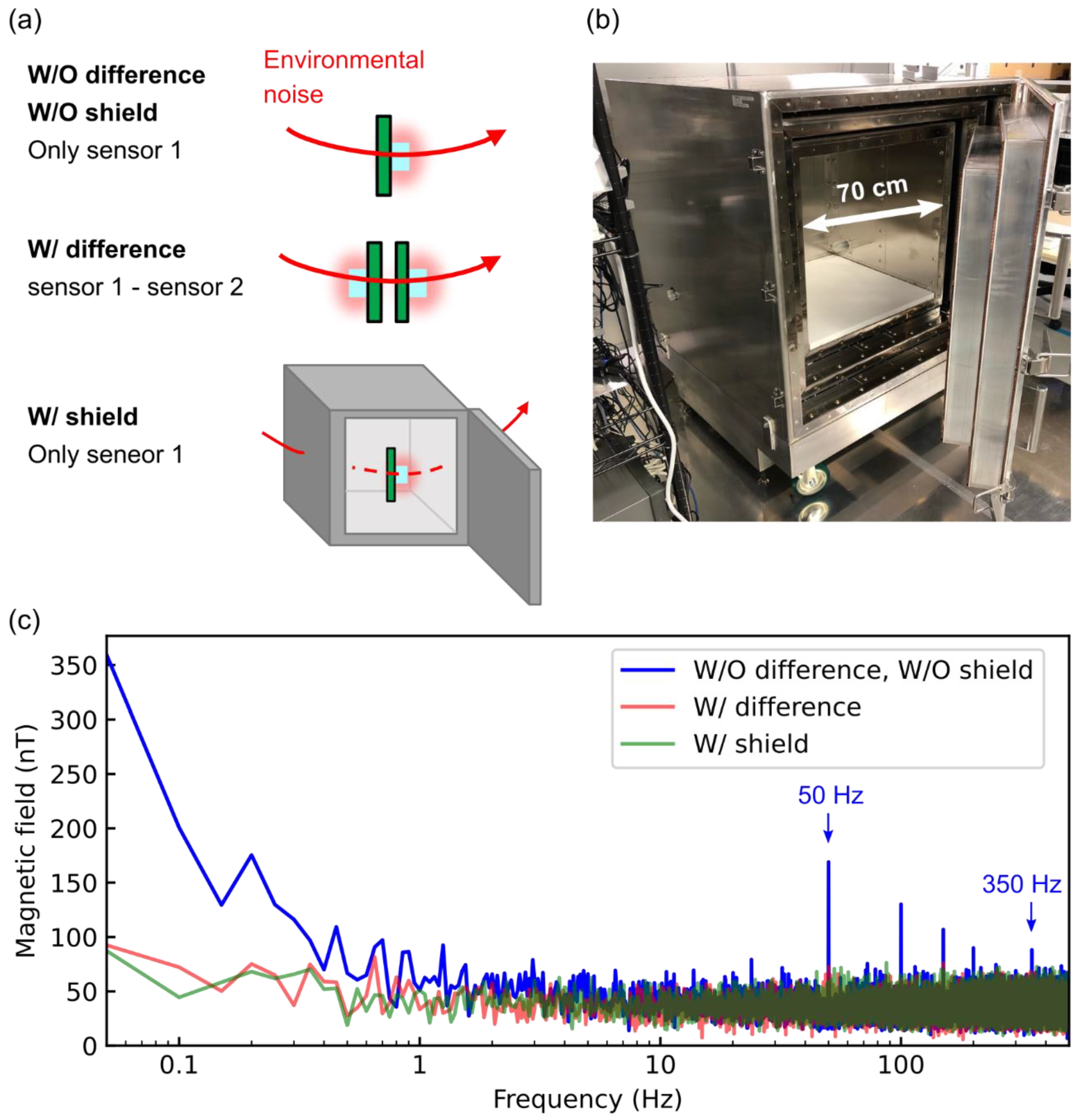Gradiometer Using Separated Diamond Quantum Magnetometers
Abstract
1. Introduction
2. Materials and Methods
3. Results and Discussion
3.1. Cancellation of a Spatially Homogeneous Magnetic Field Noise
3.2. Base Length Dependence
3.3. Comparison between Gradiometor and Magnetically Shielded Enclosure
4. Conclusions
Author Contributions
Funding
Institutional Review Board Statement
Informed Consent Statement
Data Availability Statement
Conflicts of Interest
Appendix A

References
- Taylor, J.M.; Cappellaro, P.; Childress, L.; Jiang, L.; Budker, D.; Hemmer, P.R.; Yacoby, A.; Walsworth, R.L.; Lukin, M.D. High-Sensitivity Diamond Magnetometer with Nanoscale Resolution. Nat. Phys. 2008, 4, 810–816. [Google Scholar] [CrossRef]
- Doherty, M.W.; Manson, N.B.; Delaney, P.; Jelezko, F.; Wrachtrup, J.; Hollenberg, L.C.L. The Nitrogen-Vacancy Colour Centre in Diamond. Phys. Rep. 2013, 528, 1–45. [Google Scholar] [CrossRef]
- Schirhagl, R.; Chang, K.; Loretz, M.; Degen, C.L. Nitrogen-Vacancy Centers in Diamond: Nanoscale Sensors for Physics and Biology. Annu. Rev. Phys. Chem. 2014, 65, 83–105. [Google Scholar] [CrossRef] [PubMed]
- Stepanov, V.; Cho, F.H.; Abeywardana, C.; Takahashi, S. High-Frequency and High-Field Optically Detected Magnetic Resonance of Nitrogen-Vacancy Centers in Diamond. Appl. Phys. Lett. 2015, 106, 063111. [Google Scholar] [CrossRef]
- Doherty, M.W.; Struzhkin, V.V.; Simpson, D.A.; McGuinness, L.P.; Meng, Y.; Stacey, A.; Karle, T.J.; Hemley, R.J.; Manson, N.B.; Hollenberg, L.C.L.; et al. Electronic Properties and Metrology Applications of the Diamond NV−Center under Pressure. Phys. Rev. Lett. 2014, 112, 047601. [Google Scholar] [CrossRef] [PubMed]
- Thiel, L.; Rohner, D.; Ganzhorn, M.; Appel, P.; Neu, E.; Muller, B.; Kleiner, R.; Koelle, D.; Maletinsky, P. Quantitative Nanoscale Vortex Imaging Using a Cryogenic Quantum Magnetometer. Nat. Nanotechnol. 2016, 11, 677–681. [Google Scholar] [CrossRef] [PubMed]
- Yip, K.Y.; Ho, K.O.; Yu, K.Y.; Chen, Y.; Zhang, W.; Kasahara, S.; Mizukami, Y.; Shibauchi, T.; Matsuda, Y.; Goh, S.K.; et al. Measuring Magnetic Field Texture in Correlated Electron Systems under Extreme Conditions. Science 2019, 366, 1355–1359. [Google Scholar] [CrossRef]
- Yu, S.J.; Kang, M.W.; Chang, H.C.; Chen, K.M.; Yu, Y.C. Bright Fuorescent Nanodiamonds: No Photobleaching and Low CY-Totoxicity. J. Am. Chem. Soc. 2005, 127, 17604–17605. [Google Scholar] [CrossRef]
- Igarashi, R.; Yoshinari, Y.; Yokota, H.; Sugi, T.; Sugihara, F.; Ikeda, K.; Sumiya, H.; Tsuji, S.; Mori, I.; Tochio, H.; et al. Real-Time Background-Free Selective Imaging Fluorescent Nanodiamonds in Vivo. Nano Lett. 2012, 12, 5726–5732. [Google Scholar] [CrossRef]
- Hsiao, W.W.-W.; Hui, Y.Y.; Tsai, P.-C.; Chang, H.-C. Fluorescent Nanodiamond: A Versatile Tool for Long-Term Cell Tracking, Super-Resolution Imaging, and Nanoscale Temperature Sensing. Accounts Chem. Res. 2016, 49, 400–407. [Google Scholar] [CrossRef]
- Barry, J.F.; Turner, M.J.; Schloss, J.M.; Glenn, D.R.; Song, Y.; Lukin, M.D.; Park, H.; Walsworth, R.L. Optical Magnetic Detection of Single-Neuron Action Potentials Using Quantum Defects in Diamond. Proc. Natl. Acad. Sci. USA 2017, 114, E6730. [Google Scholar] [CrossRef] [PubMed]
- Webb, J.L.; Clement, J.D.; Troise, L.; Ahmadi, S.; Johansen, G.J.; Huck, A.; Andersen, U.L. Nanotesla Sensitivity Magnetic Field Sensing Using a Compact Diamond Nitrogen-Vacancy Magnetometer. Appl. Phys. Lett. 2019, 114, 231103. [Google Scholar] [CrossRef]
- Stürner, F.M.; Brenneis, A.; Kassel, J.; Wostradowski, U.; Rölver, R.; Fuchs, T.; Nakamura, K.; Sumiya, H.; Onoda, S.; Isoya, J.; et al. Compact Integrated Magnetometer Based on Nitrogen-Vacancy Centres in Diamond. Diam. Relat. Mater. 2019, 93, 59–65. [Google Scholar] [CrossRef]
- Wolf, T.; Neumann, P.; Nakamura, K.; Sumiya, H.; Ohshima, T.; Isoya, J.; Wrachtrup, J. Subpicotesla Diamond Magnetometry. Phys. Rev. X 2015, 5, 041001. [Google Scholar] [CrossRef]
- Fescenko, I.; Jarmola, A.; Savukov, I.; Kehayias, P.; Smits, J.; Damron, J.; Ristoff, N.; Mosavian, N.; Acosta, V.M. Diamond Magnetometer Enhanced by Ferrite Flux Concentrators. Phys. Rev. Res. 2020, 2, 023394. [Google Scholar] [CrossRef]
- Cohen, D. Magnetoencephalography: Evidence of Magnetic Fields Produced by Alpha-Rhythm Currents. Science 1968, 161, 784–786. [Google Scholar] [CrossRef]
- Cohen, D. Magnetoencephalography: Detection of the Brain’s Electrical Activity with a Superconducting Magnetometer. Science 1972, 175, 664–666. [Google Scholar] [CrossRef]
- Hari, R.; Salmelin, R. Magnetoencephalography: From SQUIDs to Neuroscience: Neuroimage 20th Anniversary Special Edition. NeuroImage 2012, 61, 386–396. [Google Scholar] [CrossRef]
- Xia, H.; Baranga, A.B.-A.; Hoffman, D.K.; Romalis, M.V. Magnetoencephalography with an Atomic Magnetometer. Appl. Phys. Lett. 2006, 89, 211104. [Google Scholar] [CrossRef]
- Boto, E.; Holmes, N.; Leggett, J.; Roberts, G.; Shah, V.; Meyer, S.S.; Muñoz, L.D.; Mullinger, K.J.; Tierney, T.M.; Bestmann, S.; et al. Moving Magnetoencephalography Towards Real-World Applications with a Wearable System. Nat. Cell Biol. 2018, 555, 657–661. [Google Scholar] [CrossRef]
- Zimmerman, J.E. SQUID Instruments and Shielding for Low-Level Magnetic Measurements. J. Appl. Phys. 1977, 48, 702–710. [Google Scholar] [CrossRef]
- Kelhä, V.; Pukki, J.; Peltonen, R.; Penttinen, A.; Ilmoniemi, R.J.; Heino, J. Design, Construction, and Performance of a Large-Volume Magnetic Shield. IEEE Trans. Magn. 1982, 18, 260–270. [Google Scholar] [CrossRef]
- Tumanski, S. Induction Coil Sensors—A Review. Meas. Sci. Technol. 2007, 18, R31. [Google Scholar] [CrossRef]
- Bison, G.; Wynands, R.; Weis, A. A Laser-Pumped Magnetometer for the Mapping of Human Cardiomagnetic Fields. Appl. Phys. A 2003, 76, 325–328. [Google Scholar] [CrossRef]
- Sheng, D.; Perry, A.R.; Krzyzewski, S.P.; Geller, S.; Kitching, J.; Knappe, S. A Microfabricated Optically-Pumped Magnetic Gradiometer. Appl. Phys. Lett. 2017, 110, 031106. [Google Scholar] [CrossRef] [PubMed]
- Shin, C.S.; Avalos, C.E.; Butler, M.C.; Trease, D.R.; Seltzer, S.J.; Mustonen, J.P.; Kennedy, D.J.; Acosta, V.M.; Budker, D.; Pines, A.; et al. Room-Temperature Operation of a Radiofrequency Diamond Magnetometer near the Shot-Noise Limit. J. Appl. Phys. 2012, 112, 124519. [Google Scholar] [CrossRef]
- Blakley, S.M.; Fedotov, I.V.; Becker, J.; Zheltikov, A.M. Quantum Stereomagnetometry with a Dual-Core Photonic-Crystal Fiber. Appl. Phys. Lett. 2018, 113, 011112. [Google Scholar] [CrossRef]
- Masuyama, Y.; Mizuno, K.; Ozawa, H.; Ishiwata, H.; Hatano, Y.; Ohshima, T.; Iwasaki, T.; Hatano, M. Extending Coherence Time of Macro-Scale Diamond Magnetometer by Dynamical Decoupling with Coplanar Waveguide Resonator. Rev. Sci. Instrum. 2018, 89, 125007. [Google Scholar] [CrossRef]
- Capelli, M.; Heffernan, A.; Ohshima, T.; Abe, H.; Jeske, J.; Hope, A.; Greentree, A.; Reineck, P.; Gibson, B. Increased Nitro-Gen-Vacancy Centre Creation Yield in Diamond through Electron Beam Irradiation at High Temperature. Carbon 2019, 143, 714–719. [Google Scholar] [CrossRef]
- Schloss, J.M.; Barry, J.F.; Turner, M.J.; Walsworth, R.L. Simultaneous Broadband Vector Magnetometry Using Solid-State Spins. Phys. Rev. Appl. 2018, 10, 034044. [Google Scholar] [CrossRef]
- Clevenson, H.; Pham, L.M.; Teale, C.; Johnson, K.; Englund, D.R.; Braje, D.A. Robust High-Dynamic-Range Vector Magnetometry with Nitrogen-Vacancy Centers in Diamond. Appl. Phys. Lett. 2018, 112, 252406. [Google Scholar] [CrossRef]
- Fagaly, R.L. Superconducting Quantum Interference Device Instruments and Applications. Rev. Sci. Instrum. 2006, 77, 101101. [Google Scholar] [CrossRef]







Publisher’s Note: MDPI stays neutral with regard to jurisdictional claims in published maps and institutional affiliations. |
© 2021 by the authors. Licensee MDPI, Basel, Switzerland. This article is an open access article distributed under the terms and conditions of the Creative Commons Attribution (CC BY) license (http://creativecommons.org/licenses/by/4.0/).
Share and Cite
Masuyama, Y.; Suzuki, K.; Hekizono, A.; Iwanami, M.; Hatano, M.; Iwasaki, T.; Ohshima, T. Gradiometer Using Separated Diamond Quantum Magnetometers. Sensors 2021, 21, 977. https://doi.org/10.3390/s21030977
Masuyama Y, Suzuki K, Hekizono A, Iwanami M, Hatano M, Iwasaki T, Ohshima T. Gradiometer Using Separated Diamond Quantum Magnetometers. Sensors. 2021; 21(3):977. https://doi.org/10.3390/s21030977
Chicago/Turabian StyleMasuyama, Yuta, Katsumi Suzuki, Akira Hekizono, Mitsuyasu Iwanami, Mutsuko Hatano, Takayuki Iwasaki, and Takeshi Ohshima. 2021. "Gradiometer Using Separated Diamond Quantum Magnetometers" Sensors 21, no. 3: 977. https://doi.org/10.3390/s21030977
APA StyleMasuyama, Y., Suzuki, K., Hekizono, A., Iwanami, M., Hatano, M., Iwasaki, T., & Ohshima, T. (2021). Gradiometer Using Separated Diamond Quantum Magnetometers. Sensors, 21(3), 977. https://doi.org/10.3390/s21030977






